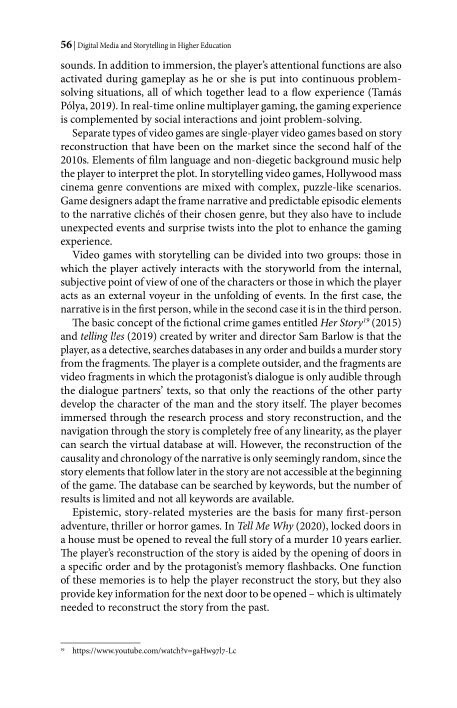

OCR
56 | Digital Media and Storytelling in Higher Education sounds. In addition to immersion, the player’s attentional functions are also activated during gameplay as he or she is put into continuous problemsolving situations, all of which together lead to a flow experience (Tamas Polya, 2019). In real-time online multiplayer gaming, the gaming experience is complemented by social interactions and joint problem-solving. Separate types of video games are single-player video games based on story reconstruction that have been on the market since the second half of the 2010s. Elements of film language and non-diegetic background music help the player to interpret the plot. In storytelling video games, Hollywood mass cinema genre conventions are mixed with complex, puzzle-like scenarios. Game designers adapt the frame narrative and predictable episodic elements to the narrative clichés of their chosen genre, but they also have to include unexpected events and surprise twists into the plot to enhance the gaming experience. Video games with storytelling can be divided into two groups: those in which the player actively interacts with the storyworld from the internal, subjective point of view of one of the characters or those in which the player acts as an external voyeur in the unfolding of events. In the first case, the narrative is in the first person, while in the second case it is in the third person. The basic concept of the fictional crime games entitled Her Story’? (2015) and telling Iles (2019) created by writer and director Sam Barlow is that the player, as a detective, searches databases in any order and builds a murder story from the fragments. The player is a complete outsider, and the fragments are video fragments in which the protagonist’s dialogue is only audible through the dialogue partners’ texts, so that only the reactions of the other party develop the character of the man and the story itself. The player becomes immersed through the research process and story reconstruction, and the navigation through the story is completely free of any linearity, as the player can search the virtual database at will. However, the reconstruction of the causality and chronology of the narrative is only seemingly random, since the story elements that follow later in the story are not accessible at the beginning of the game. The database can be searched by keywords, but the number of results is limited and not all keywords are available. Epistemic, story-related mysteries are the basis for many first-person adventure, thriller or horror games. In Tell Me Why (2020), locked doors in a house must be opened to reveal the full story of a murder 10 years earlier. The player’s reconstruction of the story is aided by the opening of doors in a specific order and by the protagonist’s memory flashbacks. One function of these memories is to help the player reconstruct the story, but they also provide key information for the next door to be opened - which is ultimately needed to reconstruct the story from the past. » https://www.youtube.com/watch?v=gaHw97l7-Lc
Szerkezeti
Custom
Image Metadata
- Kép szélessége
- 1831 px
- Kép magassága
- 2835 px
- Képfelbontás
- 300 px/inch
- Kép eredeti mérete
- 1.34 MB
- Permalinkből jpg
- 022_000040/0056.jpg
- Permalinkből OCR
- 022_000040/0056.ocr
Bejelentkezés
Magyarhu
